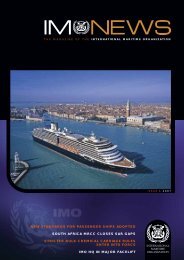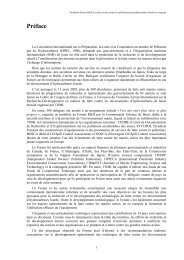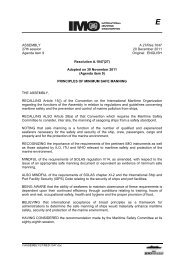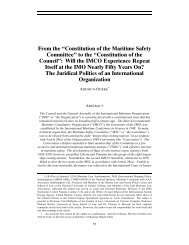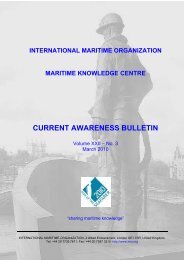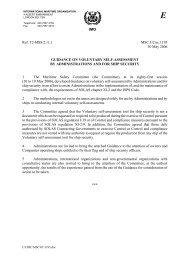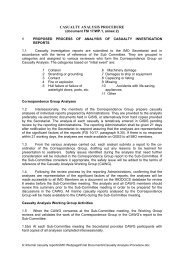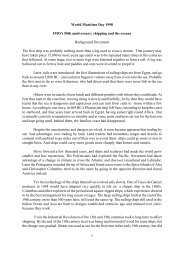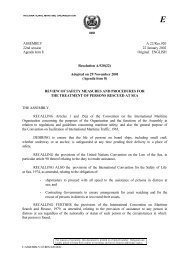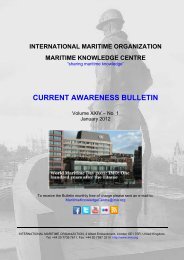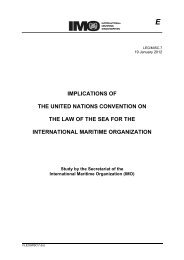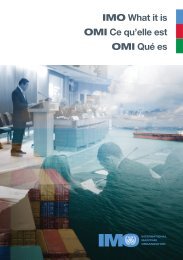Radioactive Waste Disposal at Sea: Public Ideas ... - IMO
Radioactive Waste Disposal at Sea: Public Ideas ... - IMO
Radioactive Waste Disposal at Sea: Public Ideas ... - IMO
Create successful ePaper yourself
Turn your PDF publications into a flip-book with our unique Google optimized e-Paper software.
220 Notes to pp. 122–127<br />
the Pacific, the Black <strong>Sea</strong>, the Red <strong>Sea</strong>, and the Baltic are all in danger of destruction.”<br />
(U.S. Sen<strong>at</strong>e, Intern<strong>at</strong>ional Conference on Ocean Pollution, p. 39) And, a second<br />
illustr<strong>at</strong>ion: “The shores of United St<strong>at</strong>es w<strong>at</strong>erways have been so invaded by<br />
pollutants, th<strong>at</strong> evidence indic<strong>at</strong>es the n<strong>at</strong>ion already has a number of “dead” seas:<br />
some parts of Lake Erie, the Houston Ship Canal, San Pedro Bay, the upper<br />
Delaware River, off the Hudson Estuary, and others. Elsewhere on earth, the<br />
Caspian <strong>Sea</strong>, the Baltic <strong>Sea</strong>, the Irish <strong>Sea</strong>, the Sounds between Sweden and Denmark,<br />
the North <strong>Sea</strong>, and the <strong>Sea</strong> of Japan can be found in varying stages of entrophic<strong>at</strong>ion.<br />
Perhaps the most shocking example of the developed n<strong>at</strong>ions’ apparent lack<br />
of concern about the quality of their w<strong>at</strong>ers is the Cuyahoga River in Cleveland,<br />
Ohio, which actually burst into flame in 1969.” (Weinstein-Bacal 1978, p. 875.)<br />
21. See, e.g., “New York’s Dead <strong>Sea</strong>,” Newsweek, February 23, 1970, p. 86.<br />
22. See Grayson and Shepard 1973, p. 66.<br />
23. “Danish deleg<strong>at</strong>es said the Baltic <strong>Sea</strong> is already subject to such oxygen starv<strong>at</strong>ion<br />
as to be almost dead, and th<strong>at</strong> the North <strong>Sea</strong> is rapidly becoming the same.”<br />
This quote from Friendly 1971 appears on p. 199 of U.S. Sen<strong>at</strong>e, Ocean <strong>Waste</strong><br />
<strong>Disposal</strong>.<br />
24. For example, Heyerdahl concluded his speech <strong>at</strong> the Intern<strong>at</strong>ional Institute for<br />
Environmental Affairs’ seminar series held concurrently with the Stockholm<br />
Conference with these words: “. . . the revolving ocean, indispensable and yet vulnerable,<br />
will forever remain a common human heritage” (Heyerdahl 1973, p. 63).<br />
In an essay titled “Stop Killing Our Oceans,” Sen. Gaylord Nelson wrote: “Finally,<br />
all n<strong>at</strong>ions together must establish an Intern<strong>at</strong>ional Policy on the <strong>Sea</strong> th<strong>at</strong> sacrifices<br />
narrow self-interest for the protection of this vast domain th<strong>at</strong> is a common heritage<br />
of all mankind.” (Congressional Record: Sen<strong>at</strong>e, February 8, 1971, p. 2036)<br />
25. See Weart 1988, p. 325.<br />
26. See Linsky 1990, p. 206.<br />
27. See Kingdon 1984, pp. 62–63.<br />
28. According to a close observer, “it was not until the [the Prepar<strong>at</strong>ory Committee]<br />
met for the third time in September of 1971 th<strong>at</strong> it had become clear th<strong>at</strong> the job of<br />
educ<strong>at</strong>ing the public and their political leaders had already been partly accomplished<br />
through the explosion of public interest in environmental m<strong>at</strong>ters, and th<strong>at</strong> the<br />
Stockholm conference would have to produce some concrete action if it were to be<br />
taken seriously by observers around the world” (Rowland 1973, p. 87).<br />
29. On the success of the Stockholm conference, see, e.g., Hawkes 1972b, pp.<br />
1308–1310; “Mr Strong’s Recipe,” N<strong>at</strong>ure 237 (June 23, 1972), pp. 418–419. One<br />
analyst concluded th<strong>at</strong> the prepar<strong>at</strong>ions for and subsequent convening of the<br />
Stockholm conference had “apparently heightened environmental consciousness<br />
intern<strong>at</strong>ionally” (Soroos 1981, p. 30).<br />
30. “Only One Earth” was the conference’s epigram.<br />
31. Many represent<strong>at</strong>ives of the scientific community were skeptical about the quality<br />
of scientific knowledge about environmental impact of pollutants. See, e.g.,<br />
Myrdal 1973, pp. 70–71. Strong’s position marked a compromise between environmental<br />
crusaders and their critics. For a discussion, see Handelman et al. 1974, p. 76.



